Abstract
Methyl ammonium antimony iodide (MA3Sb2I9) perovskite-like materials have gained enormous attention from the scientific community because of their excellent aerobic stability, good optical properties, and less-toxic nature. Herein, we report on the simulation of FTO/TiO2/MA3Sb2I9/spiro-OMeTAD via solar cell capacitance (SCAPS) software. The thickness of the absorber layer, hole-transport layer, or electron-transport layer may significantly impact the photovoltaic performance of the perovskite solar cells (PSCs). In this connection, the thickness of the absorber layer, hole-transport layer, or electron-transport layer was varied during the simulation process and the optimized PSCs demonstrated a good efficiency of 14.90% including an excellent open circuit voltage (Voc) of 1.41 V. Furthermore, we also fabricated MA3Sb2I9-based PSCs and their photovoltaic performance was evaluated. The fabricated PSCs showed a reasonably good efficiency of 1.27% and Voc of 0.51 V.
1. Introduction
In the past few years, a rapid surge in the construction of perovskite solar cells (PSCs) has been noticed [1,2,3,4,5,6,7,8,9]. PSCs were developed by Kojima et al. [1], and an interesting PCE of more than 3% was achieved. Although a low PCE of less than 4% was reported in this work, this work opens a new window toward developing novel thin film-based photovoltaic cells. Organic–inorganic hybrid perovskite materials such as methyl ammonium lead iodide (CH3NH3PbI3) and methyl ammonium lead bromide (CH3NH3PbBr3) have been used as visible light sensitizers [1]. Furthermore, this efficiency was also enhanced to 6.5% by Im et al. [10] using novel approaches. In other investigations, this efficiency was also boosted to more than 9% by utilizing a solid-state hole-transport material (HTM) [11].
Furthermore, a large number of unique efforts such as new fabrication techniques (two-step deposition method, vacuum deposition method, or sequential deposition method) and various electron transport layer (ETL) or HTM layers have been employed by materials scientists [12,13,14,15,16,17,18,19]. Using such unique and novel strategies has boosted the efficiency of CH3NH3PbI3-based PSCs [5]. In previous years, the highest efficiency of more than 25% has been reported, which showed the potential of PSCs for practical purposes [5]. Despite this excellent photovoltaic performance, CH3NH3PbI3-based PSCs suffer from poor long-term stability, moisture sensitivity, and the presence of toxic Pb2+ in the absorber layer (CH3NH3PbI3) [14]. The air stability of the Pb2+-containing perovskite has been improved to some extent by various research groups via the introduction of hydrophobic cationic groups into the perovskite materials [14]. However, the presence of toxic Pb2+ still concerns the scientific community [20,21,22,23,24]. The previous study demonstrated that the presence of Pb2+ in PSCs can be neglected, but the actual environmental impact of Pb2+ from perovskite materials is still unknown [22].
It is important to design and develop Pb2+ free perovskite absorber materials. In this connection, Snaith and co-workers explored tin-based material (i.e., methyl ammonium tin iodide (CH3NH3SnI3)) as a light absorber material for the construction of Pb2+ free PSCs [20]. The developed Pb2+ free PSCs exhibited good efficiency of more than 6%, which opened new doors for the scientific community toward developing Pb2+ free PSCs [20]. This work showed the potential of the Pb2+ free absorber layer for developing high-performance Pb2+ free PSCs. In further reports, various efforts have been made by researchers working on developing PSCs, and the highest efficiency of more than 12% was achieved for tin halide-based PSCs [22]. Tin-based perovskite materials possess a less toxic nature, low band gap, and excellent electrical properties. Although tin-based perovskite materials are promising light-absorbing candidates, the poor stability of tin in aerobic conditions is a major concern for the scientific community [20]. Tin has a +2 oxidation state in perovskite materials, which can rapidly change to a +4 oxidation state under ambient conditions [25]. Thus, it can be easily understood that CH3NH3SnI3 can be degraded in air, which restricts its potential application in the construction of PSCs for practical or commercialization purposes [26,27,28,29,30,31]. Thus, it can be said that the design and fabrication of stable Pb2+ free perovskite materials are of great significance. Hence, some other Pb2+ free perovskites and perovskite-like structures such as methyl ammonium bismuth iodide (MA3Bi2I9), copper-based perovskites (C6H4NH2CuCl2I and C6H4NH2CuBr2I), methyl ammonium antimony iodide (MA3Sb2I9), ammonium bismuth iodide (NH4Bi2I9), and ammonium antimony iodide (NH4Sb2I9) have been investigated as light absorber materials [16,17,18,19]. Among them, MA3Sb2I9 is one of the potential candidates for the fabrication of stable Pb2+ free PSCs [19]. The simulation of PSCs via solar cell capacitance software (SCAPS) has recently received extensive attention. Many simulation studies have demonstrated good photovoltaic performance [21]. It has also been observed that simulation studies may be helpful in obtaining a high efficiency of the fabricated PSCs experimentally [21].
Herein, we simulated MA3Sb2I9-based PSCs via SCAPS, demonstrating good photovoltaic performance. Furthermore, we have also fabricated PSCs showing reasonable photovoltaic performance in efficiency and open circuit voltage. So far, no report on the simulation of MA3Sb2I9-based PSCs via SCAPS is available. This is the first report on the simulation and experimental investigations of MA3Sb2I9-based PSCs.
2. Experimental Section
2.1. Simulation of PSCs
The simulation studies were conducted on SCAPS software, and this software used continuity equations and Poisson’s equations for simulation investigations, which are provided in the Supplementary Materials. The authors also thank Prof. M. Burgelman, University of Gent, Belgium, for providing access to SCAPS.
2.2. Chemicals
Chemicals such as antimony iodide (SbI3; 99.998% metal base) and FTO were purchased from Sigma. We bought the additive salts from Sigma Aldrich, St. Louis, MO, USA including tert-butylpyridine (tBP) and bis-(trifluoromethane) sulfonimide lithium. Sigma provided the 2,2′,7,7′-tetrakis (N,N-di-p-methoxyphenylamine)9,9′-spirobifluorene (spiro-OMeTAD) (99.7%) hole transport material. Other materials included tris(2-(1 H-pyrazol-1-yl)4-tert-butylpyridine)-cobalt(III) tris (bis-(trifluoromethylsulfonyl)imide) (FK209-cobalt(III)-TFSI), titanium diisopropoxide bis(acetylacetonate), fluorine-doped tin oxide/glass, and other solvents were purchased from TCI and Merck.
2.3. Fabrication of PSCs
PSC devices were fabricated under a glove box filled with nitrogen. Fabrication details are provided in the Supplementary Materials.
3. Results and Discussion
3.1. Numerical Investigations
A MA3Sb2I9-based PSC device was simulated under standard conditions (1 sun condition) on SCAPS software. The photovoltaic parameters include the fill factor (FF), open circuit voltage (Voc), photocurrent density (Jsc), and power conversion efficiency (PCE) of the MA3Sb2I9 based PSC devices were determined by obtaining their photocurrent density versus voltage (J–V) curve. The obtained J–V response of the MA3Sb2I9-based PSC device with the architecture of FTO/TiO2/MA3Sb2I9/spiro-OMeTAD is shown in Figure 1a. The thickness of the TiO2 was 150 nm, whereas the thickness of spiro-OMeTAD was 350 nm including a 250 nm thick MA3Sb2I9 layer. The Voc of 1.45 V and Jsc of 9.31 mA/cm2, including PCE of 11.80% were obtained for the above-simulated PSC device (Figure 1a). The TiO2 layer plays a vital role in the charge transfer and extraction process and significantly affects the PCE of the PSCs. Therefore, it is important to study the effect of the thickness of the TiO2 layer on the photovoltaic performance of the FTO/TiO2/MA3Sb2I9/spiro-OMeTAD PSCs. The PSC device (FTO/TiO2/MA3Sb2I9/spiro-OMeTAD) was simulated at various thicknesses (150 nm, 250 nm, 350 nm, and 500 nm) of the TiO2 layer and the thickness of the MA3Sb2I9 (250 nm) and spiro-OMeTAD (350 nm) was not changed. The obtained J–V responses are shown in Figure 1b, while the extracted photovoltaic parameters from the obtained J–V curves are shown in Figure 1c. The observed results indicate that the PCE of the simulated PSC device decreased with the thickness of the TiO2 layer. It can be said that a thin layer of TiO2 (150 nm) is suitable for achieving a high efficiency of the FTO/TiO2/MA3Sb2I9/spiro-OMeTAD PSCs.
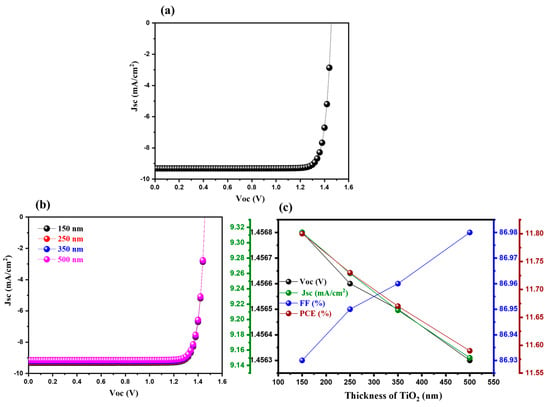
Figure 1.
J–V response (a) of FTO/TiO2(150 nm)/MA3Sb2I9(250 nm)/spiro-OMeTAD(350 nm). J–V response (b) and corresponding photovoltaic parameters (c) of FTO/TiO2(150–500 nm)/MA3Sb2I9(250 nm)/spiro-OMeTAD(350 nm).
Hence, a 150 nm thick TiO2 layer was applied for further simulation investigations. Since the thickness of spiro-OMeTAD can influence the performance of the FTO/TiO2/MA3Sb2I9/spiro-OMeTAD PSCs, in this regard, we varied the thickness (150 nm, 250 nm, 350 nm, and 500 nm) of the spiro-OMeTAD layer, whereas the thickness of the MA3Sb2I9 layer was 250 nm. The collected J–V responses and J–V parameters are shown in Figure 2a,b, respectively. The simulated results show that the PCE of the FTO/TiO2/MA3Sb2I9/spiro-OMeTAD PSCs slightly increased with a decreasing thickness of the spiro-OMeTAD layer. A relatively higher PCE of 11.82% was achieved for the 150 nm thick spiro-OMeTAD layer (Figure 2b). Therefore, a 150 nm thick spiro-OMeTAD layer was used for further investigations. The thicknesses of the TiO2 and spiro-OMeTAD layers were optimized to obtain high-performance PSCs. However, the thickness of the MA3Sb2I9 may play a crucial role due to its light-absorbing nature and properties. It is important to study the effect of the MA3Sb2I9 thickness on the J–V parameters of the simulated PSCs. In this connection, we used various thicknesses of MA3Sb2I9 from 250 to 700 nm for further simulation.
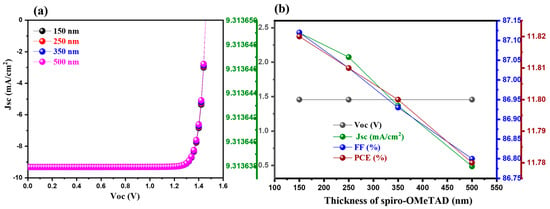
Figure 2.
J–V responses (a) and photovoltaic parameters (b) of the FTO/TiO2(150 nm)/MA3Sb2I9(250 nm)/spiro-OMeTAD(150–350 nm).
The J–V responses and J–V parameters of the FTO/TiO2/MA3Sb2I9/spiro-OMeTAD PSCs with a different applied thickness of MA3Sb2I9 are shown in Figure 3a,b, respectively. The simulated FTO/TiO2/MA3Sb2I9/spiro-OMeTAD PSCs with a 250 nm thick MA3Sb2I9 layer demonstrated that the PCE of 11.82% was significantly improved to 13.46% on using a 350 nm thick MA3Sb2I9 layer (Figure 3b). Furthermore, this PCE of 13.46% was enhanced to 14.38% using a 450 nm thick MA3Sb2I9 layer. Interestingly, the highest PCE of 15.28% was achieved for the 700 nm thick MA3Sb2I9 layer. This indicates that the thickness of the MA3Sb2I9 layer largely influences the J–V characteristics of the FTO/TiO2/MA3Sb2I9/spiro-OMeTAD PSCs. The J–V characteristics of the best-performing PSC device via SCAPS are compared with recent reports in Table 1.
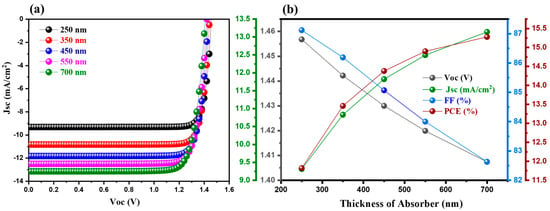
Figure 3.
J–V responses (a) and photovoltaic parameters (b) of the FTO/TiO2(150 nm)/MA3Sb2I9(250–700 nm)/spiro-OMeTAD(150).

Table 1.
Comparison of the Voc, Jsc, F.F., and PCE of the simulated MA3Sb2I9-based PSCs with the recently reported articles.
3.2. Performance Evaluation of Fabricated MA3Sb2I9-Based PSCs
To characterize the prepared film of MA3Sb2I9, X-ray diffraction (XRD) and scanning electron microscopy (SEM) techniques were adopted, which suggest the formation of a MA3Sb2I9 film on the FTO substrate. We obtained an XRD pattern of the fabricated thin film of MA3Sb2I9 on the FTO at the 2theta range of 10–40°. Figure 4 shows the recorded XRD data of the prepared MA3Sb2I9 on the FTO substrate. The XRD pattern exhibited (002), (003), and (402) diffraction planes of MA3Sb2I9 and revealed that MA3Sb2I9 had been grown on an FTO glass substrate. The MA3Sb2I9 belongs to the bismuth based perovskite-like family [42].
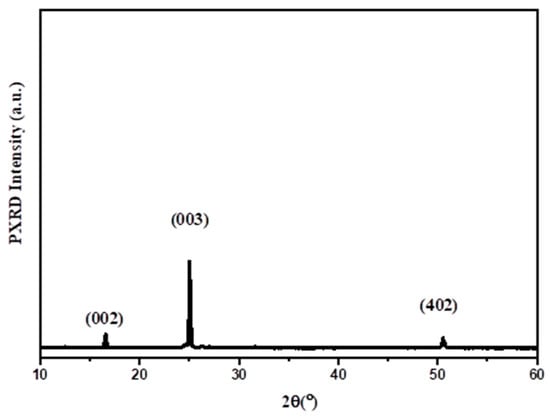
Figure 4.
XRD pattern of the prepared MA3Sb2I9 film on the FTO substrate.
The Ultraviolet–Visible (UV–Vis) spectrum of the fabricated thin film of MA3Sb2I9 was also obtained. Figure 5 shows the UV–Vis spectrum of the MA3Sb2I9, and it can be seen that a broad absorption band was present at the wavelength of 450–650 nm. The band gap of the prepared MA3Sb2I9 can be calculated by using the Tauc-relation. In this context, the Tauc plot of the MA3Sb2I9 was plotted by using the Tauc relation, as given below,
where α is the absorption coefficient; Eg is the band gap energy; v is the frequency; and m= transition value. The (αhv)1/2 as a function of hv has been plotted in the inset of Figure 4. The MA3Sb2I9 has an indirect band gap of 2.05 eV, as suggested by the Tauc plot (inset of Figure 4).
αhv = A (hv − Eg)m
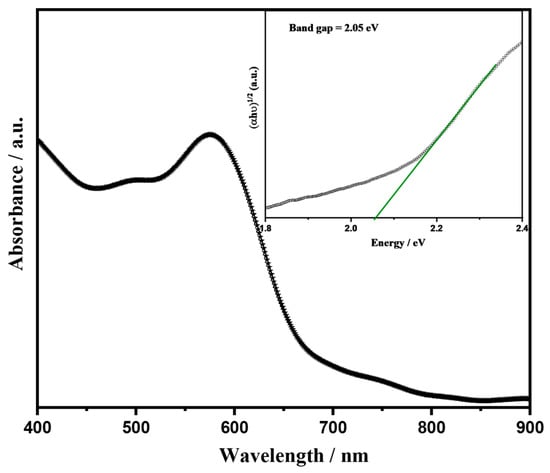
Figure 5.
UV–Vis spectrum of the prepared thin film of MA3Sb2I9 on the FTO substrate. Inset; Tauc plot.
The field emission scanning electron microscopy (FESEM) images of MA3Sb2I9 were also obtained on the microscope to check the morphological feature of the MA3Sb2I9 film. The FESEM images of the MA3Sb2I9 are presented in Figure 6a,b. The observation suggests that MA3Sb2I9 was grown uniformly on the FTO substrate including large particles.
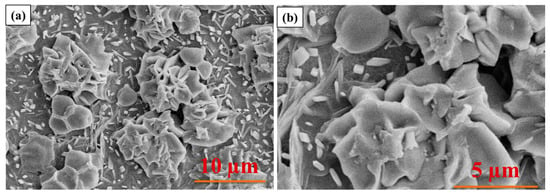
Figure 6.
FESEM images (a,b) of the prepared thin film of MA3Sb2I9 on the FTO substrate at different magnifications.
Furthermore, we fabricated Pb2+ free PSCs using MA3Sb2I9 as an absorber material whereas TiO2 and spiro-OMeTAD were the electron transport layer (ETL) and hole-transport layer (HTL), respectively. A schematic picture of the fabricated Pb2+ free PSCs is shown in Scheme 1a. The energy level diagram of the fabricated Pb2+ free PSCs is shown in Scheme 1b.

Scheme 1.
Schematic device structure (a) and energy level diagram (b) of the fabricated Pb2+ free PSCs.
The above investigations revealed a significant gap between the simulated and experimental PCE. However, the obtained PCE in the present work (experimental PCE) is comparable with recent reports, as shown in Table 2. We believe that this PCE may be further enhanced by adopting novel strategies to improve the morphological characteristics and fast-crystallization of MA3Sb2I9. The solar simulator was used to study the photovoltaic property of the fabricated Pb2+ free PSCs under standard conditions. The J–V response of the fabricated Pb2+ free PSCs was obtained under 1 sun. The J–V response of the fabricated Pb2+ free PSCs is provided in Figure 7. The fabricated Pb2+ free PSCs showed a good Voc of 0.51 V and reasonable PCE of 1.27%.

Table 2.
Comparison of the Voc, Jsc, F.F., and PCE of the developed Pb2+ free based Pb2+ free PSCs with the recently published PSCs.
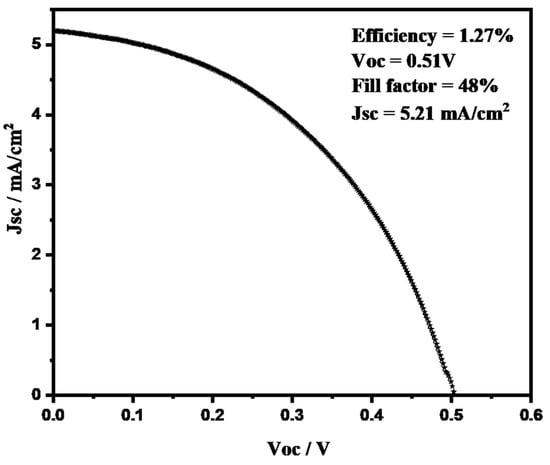
Figure 7.
J–V response of the fabricated MA3Sb2I9 based Pb2+ free PSCs.
There was a gap between the PCE of the simulated and fabricated PSC devices observed. In the simulation results, the J–V curve exhibited a Voc of 1.41 V and Jsc of 12.49 mA/cm2. Moreover, an interesting PCE of 14.90% was observed for the simulated PSCs. In the case of the experimental results, the fabricated PSCs showed an excellent Jsc of 5.21 mA/cm2 and Voc of 0.51 V. A reasonable PCE of 1.27% was also obtained for the fabricated device. The fabricated device exhibited decent performance, but a gap was still observed between the simulated and fabricated devices. This may be due to the poor morphological features and fast crystallization of the MA3Sb2I9 film. More in-depth study is required to further improve the performance of the fabricated PSCs. The J–V curve of the simulated and fabricated PSC device is presented in Figure S1.
4. Conclusions
In conclusion, we can summarize that MA3Sb2I9-based PSCs were simulated by using SCAPS. The PSCs with a device configuration of FTO/TiO2/MA3Sb2I9/spiro-OMeTAD were simulated via SCAPS. The photovoltaic performance of the simulated PSCs was investigated by photocurrent density–voltage (J–V) studies under 1 sun condition. The optimized PSCs exhibited good efficiency of 14.92% via SCAPS. Furthermore, we also prepared MA3Sb2I9 on the FTO substrate, and the results showed that MA3Sb2I9 had a band gap of 2.05 eV. In further investigations, the PSC device was fabricated using MA3Sb2I9 as the absorber material, whereas titanium dioxide (TiO2) was the electron transport layer and spiro-OMeTAD as the hole transport material. The fabricated PSCs with the device configuration of FTO/TiO2/MA3Sb2I9/spiro-OMeTAD showed good efficiency of 1.27%.
Supplementary Materials
The following supporting information can be downloaded at: https://www.mdpi.com/article/10.3390/en16010236/s1, Table S1. Numerical parameters of different materials for device simulation. Table S2. Effect of thickness of TiO2 on photovoltaic parameters. Table S3. Effect of spiro-OMeTAD thickness. Table S4. Effect of absorber layer. Figure S1. J-V responses of the simulated and fabricated PSCs device.
Author Contributions
Conceptualization, A.A.; Formal analysis, A.A., R.A.K., M.F.A. and N.A.A.; Investigation, A.A., R.A.K., M.F.A. and N.A.A.; Writing—original draft, A.A. and R.A.K.; Writing—review & editing, A.A.; Funding acquisition, A.A. All authors have read and agreed to the published version of the manuscript.
Funding
This work was funded by the Deputyship for Research & Innovation, Ministry of Education in Saudi Arabia, for funding this research work through project no. IFKSURG-2-1626.
Data Availability Statement
Not applicable.
Acknowledgments
The authors extend their appreciation to the Deputyship for Research & Innovation, Ministry of Education in Saudi Arabia, for funding this research work through project no. IFKSURG-2-1626.
Conflicts of Interest
Authors declares no conflict of interest.
References
- Kojima, A.; Teshima, K.; Shirai, Y.; Miyasaka, T. Organometal Halide Perovskites as Visible-Light Sensitizers for Photovoltaic Cells. J. Am. Chem. Soc. 2009, 131, 6050–6051. [Google Scholar] [CrossRef]
- Ahmad, K.; Kumar, P.; Mobin, S.M. Hydrothermally grown novel pyramids of the CaTiO3 perovskite as an efficient electrode modifier for sensing applications. Mater. Adv. 2020, 1, 2003–2009. [Google Scholar] [CrossRef]
- Burgelman, M.; Nollet, P.; Degrave, S. Modelling polycrystalline semiconductor solar cells. Thin Solid Film. 2000, 361, 527–532. [Google Scholar] [CrossRef]
- Ahmad, K.; Shinde, M.A.; Kim, H. Molybdenum disulfide/reduced graphene oxide: Progress in synthesis and electro-catalytic properties for electrochemical sensing and dye sensitized solar cells. Microchem. J. 2021, 169, 106583. [Google Scholar] [CrossRef]
- Jeong, J.; Kim, M.; Seo, J.; Lu, H.; Ahlawat, P.; Mishra, A.; Yang, Y.; Hope, M.A.; Eickemeyer, F.T.; Kim, M.; et al. Pseudo-halide anion engineering for α-FAPbI3 perovskite solar cells. Nature 2021, 592, 381–385. [Google Scholar] [CrossRef] [PubMed]
- Park, N.-G.; Grätzel, M.; Miyasaka, T.; Zhu, K.; Emery, K. Towards stable and commercially available perovskite solar cells. Nat. Energy 2016, 1, 16152. [Google Scholar] [CrossRef]
- Saliba, M.; Matsui, T.; Seo, J.-Y.; Domanski, K.; Correa-Baena, J.-P.; Nazeeruddin, M.K.; Zakeeruddin, S.M.; Tress, W.; Abate, A.; Hagfeldt, A.; et al. Cesium-containing triple cation perovskite solar cells: Improved stability, reproducibility and high efficiency. Energy Environ. Sci. 2016, 9, 1989–1997. [Google Scholar] [CrossRef]
- Ahmad, K.; Mobin, S.M. Graphene oxide based planar heterojunction perovskite solar cell under ambient condition. New J. Chem. 2017, 41, 14253–14258. [Google Scholar] [CrossRef]
- Ahmad, K.; Kim, H. Enhanced stability of MAPbI3 based perovskite solar cells. Mater. Lett. 2022, 318, 132187. [Google Scholar] [CrossRef]
- Im, J.-H.; Lee, C.-R.; Lee, J.-W.; Park, S.-W.; Park, N.-G. 6.5% efficient perovskite quantum-dot-sensitized solar cell. Nanoscale 2011, 3, 4088–4093. [Google Scholar] [CrossRef]
- Kim, H.-S.; Lee, C.-R.; Im, J.-H.; Lee, K.-B.; Moehl, T.; Marchioro, A.; Moon, S.-J.; Humphry-Baker, R.; Yum, J.-H.; Moser, J.E.; et al. Lead Iodide Perovskite Sensitized All-Solid-State Submicron Thin Film Mesoscopic Solar Cell with Efficiency Exceeding 9%. Sci. Rep. 2012, 2, 591. [Google Scholar] [CrossRef] [PubMed]
- Kabir, E.; Kumar, P.; Kumar, S.; Adelodun, A.A.; Kim, K.-H. Solar energy: Potential and future prospects. Renew. Sustain. Energy Rev. 2018, 82, 894–900. [Google Scholar] [CrossRef]
- Min, H.; Kim, M.; Lee, S.-U.; Kim, H.; Kim, G.; Choi, K.; Lee, J.H.; Seok, I.S. Efficient, stable solar cells by using inherent bandgap of α-phase formamidinium lead iodide. Science 2019, 366, 749–753. [Google Scholar] [CrossRef] [PubMed]
- Yang, S.; Liu, W.; Zuo, L.; Zhang, X.; Ye, T.; Chen, J.; Li, C.-Z.; Wu, G.; Chen, H. Thiocyanate assisted performance enhancement of formamidinium based planar perovskite solar cells through a single one-step solution process. J. Mater. Chem. A 2016, 4, 9430–9436. [Google Scholar] [CrossRef]
- Kumar, P.; Ahmad, K.; Dagar, J.; Unger, E.; Mobin, S.M. Two-Step Deposition Approach for Lead Free (NH4)3Sb2I9 Perovskite Solar Cells with Enhanced Open Circuit Voltage and Performance. ChemElectroChem 2021, 8, 3150–3154. [Google Scholar] [CrossRef]
- Ahmad, K.; Mobin, S.M. Organic–Inorganic Copper (II)-Based Perovskites: A Benign Approach toward Low-Toxicity and Water-Stable Light Absorbers for Photovoltaic Applications. Energy Technol. 2020, 8, 1901185. [Google Scholar] [CrossRef]
- Ahmad, K.; Ansari, S.N.; Natarajan, K.; Mobin, S.M. A (CH3NH3)3Bi2I9 perovskite Based on a Two-Step Deposition Method: Lead-Free, Highly Stable, and with Enhanced Photovoltaic Performance. ChemElectroChem 2019, 6, 1192–1198. [Google Scholar] [CrossRef]
- Ahmad, K.; Ansari, S.N.; Natarajan, K.; Mobin, S.M. Design and Synthesis of 1D-Polymeric Chain Based [(CH3NH3)3Bi2Cl9]n Perovskite: A New Light Absorber Material for Lead Free Perovskite Solar Cells. ACS Appl. Energy Mater. 2018, 1, 2405–2409. [Google Scholar] [CrossRef]
- Ahmad, K.; Kumar, P.; Mobin, S.M. A Two-Step Modified Sequential Deposition Method-based Pb-Free (CH3NH3)3Sb2I9 Perovskite with Improved Open Circuit Voltage and Performance. ChemElectroChem 2020, 7, 946–950. [Google Scholar] [CrossRef]
- Noel, N.K.; Stranks, S.D.; Abate, A.; Wehrenfennig, C.; Guarnera, S.; Haghighirad, A.-A.; Sadhanala, A.; Eperon, G.E.; Pathak, S.K.; Johnston, M.B.; et al. Lead-free organic–inorganic tin halide perovskites for photovoltaic applications. Energy Environ. Sci. 2014, 7, 3061–3068. [Google Scholar] [CrossRef]
- Lakhdar, N.; Hima, A. Electron transport material effect on performance of perovskite solar cells based on CH3NH3GeI3. Opt. Mater. 2020, 99, 109517. [Google Scholar] [CrossRef]
- Li, J.; Cao, H.-L.; Jiao, W.-B.; Wang, Q.; Wei, M.; Cantone, I.; Lü, J.; Abate, A. Biological impact of lead from halide perovskites reveals the risk of introducing a safe threshold. Nat. Commun. 2020, 11, 310. [Google Scholar] [CrossRef] [PubMed]
- Ahmad, K.; Kumar, P.; Mobin, S.M. Inorganic Pb-Free Perovskite Light Absorbers for Efficient Perovskite Solar Cells with Enhanced Performance. Chem. Asian J. 2020, 15, 2859–2863. [Google Scholar] [CrossRef] [PubMed]
- Ahmad, K.; Mobin, S.M. Recent Progress and Challenges in A3Sb2X9-Based Perovskite Solar Cells. ACS Omega 2020, 5, 28404–28412. [Google Scholar] [CrossRef] [PubMed]
- Khadka, D.B.; Shirai, Y.; Yanagida, M.; Miyano, K. Tailoring the film morphology and interface band offset of caesium bismuth iodide-based Pb-free perovskite solar cells. J. Mater. Chem. C 2019, 7, 8335–8343. [Google Scholar] [CrossRef]
- Kang, J.; Chen, S.; Hao, M.; Liu, J.; Al-Mamun, M.; Liu, P.; Wang, Y.; Yin, H.; Zhao, H. Alloying Sb into all inorganic lead-free CsBi3I10 for improving the crystal growth and photovoltaic performance. J. Mater. Chem. A 2022, 10, 19618–19625. [Google Scholar] [CrossRef]
- Kulkarni, A.; Jena, A.K.; Ikegami, M.; Miyasaka, T. Performance enhancement of AgBi2I7 solar cells by modulating a solvent-mediated adduct and tuning remnant BiI3 in one-step crystallization. Chem. Commun. 2019, 55, 4031–4034. [Google Scholar] [CrossRef]
- Pandian, M.G.M.; Khadka, D.B.; Shirai, Y.; Umedov, S.; Yanagida, M.; Subashchandran, S.; Grigorieva, A.; Miyano, K. Effect of solvent vapour annealing on bismuth triiodide film for photovoltaic applications and its optoelectronic properties. J. Mater. Chem. C 2020, 8, 12173–12180. [Google Scholar] [CrossRef]
- Kulkarni, A.; Singh, T.; Jena, A.K.; Pinpithak, P.; Ikegami, M.; Miyasaka, T. Vapor Annealing Controlled Crystal Growth and Photovoltaic Performance of Bismuth Triiodide Embedded in Mesostructured Configurations. ACS Appl. Mater. Interfaces 2018, 10, 9547–9554. [Google Scholar] [CrossRef]
- Alam, I.; Mollick, R.; Ashraf, A. Numerical simulation of Cs2AgBiBr6-based perovskite solar cell with ZnO nanorod and P3HT as the charge transport layers. Phys. B Condens. Matter 2021, 618, 413187. [Google Scholar] [CrossRef]
- Madan, J.; Shivani; Pandey, R.; Sharma, R. Device simulation of 17.3% efficient lead-free all-perovskite tandem solar cell. Sol. Energy 2020, 197, 212–222. [Google Scholar] [CrossRef]
- Ahmad, O.; Rashid, A.; Ahmed, M.W.; Nasir, M.F.; Qasim, I. Performance evaluation of Au/p-CdTe/Cs2TiI6/n-TiO2/ITO solar cell using SCAPS-1D. Opt. Mater. 2021, 117, 111105. [Google Scholar] [CrossRef]
- Ahmed, S.; Jannat, F.; Khan, A.K.; Alim, M.A. Numerical development of eco-friendly Cs2TiBr6 based perovskite solar cell with all-inorganic charge transport materials via SCAPS-1D. Optik 2020, 225, 165765. [Google Scholar] [CrossRef]
- Samanta, M.; Ahmed, S.I.; Chattopadhyay, K.K.; Bose, C. Role of various transport layer and electrode materials in enhancing performance of stable environment-friendly Cs2TiBr6 solar cell. Optik 2020, 217, 164805. [Google Scholar] [CrossRef]
- Nalianya, M.A.; Awino, C.; Barasa, H.; Odari, V.; Gaitho, F.; Omogo, B.; Mageto, M. Numerical study of lead free CsSn0.5Ge0.5I3 perovskite solar cell by SCAPS-1D. Optik 2021, 248, 168060. [Google Scholar] [CrossRef]
- Sachchidanand, G.V.; Kumar, A.; Sharma, P. Numerical simulation of novel lead-free Cs3Sb2Br9 absorber-based highly efficient perovskite solar cell. Opt. Mater. 2021, 122, 111715. [Google Scholar] [CrossRef]
- Raj, A.; Kumar, M.; Singh, P.K.; Singh, R.C.; Bherwani, H.; Gupta, A.; Anshul, A. A computational approach to investigate the suitable ETL for lead-free CsGeI3 based perovskite solar cell. Mater. Today Proc. 2021, 47, 1564–1569. [Google Scholar] [CrossRef]
- Ahmmed, S.; Karim, A.; Rahman, H.; Aktar, A.; Islam, R.; Islam, A.; Ismail, A.B.M. Performance analysis of lead-free CsBi3I10-based perovskite solar cell through the numerical calculation. Sol. Energy 2021, 226, 54–63. [Google Scholar] [CrossRef]
- Islam, T.; Jani, R.; Al Amin, S.M.; Sami, S.U.; Shorowordi, K.; Hossain, M.I.; Devgun, M.; Chowdhury, S.; Banerjee, S.; Ahmed, S. Numerical simulation studies of a fully inorganic Cs2AgBiBr6 perovskite solar device. Opt. Mater. 2020, 105, 109957. [Google Scholar] [CrossRef]
- Li, S.; Liu, P.; Pan, L.; Li, W.; Yang, S.-E.; Shi, Z.; Guo, H.; Xia, T.; Zhang, S.; Chen, Y. The investigation of inverted p-i-n planar perovskite solar cells based on FASnI3 films. Sol. Energy Mater. Sol. Cells 2019, 199, 75–82. [Google Scholar] [CrossRef]
- Dixit, H.; Punetha, D.; Pandey, S.K. Improvement in performance of lead free inverted perovskite solar cell by optimization of solar parameters. Optik 2018, 179, 969–976. [Google Scholar] [CrossRef]
- Park, B.-W.; Philippe, B.; Zhang, X.; Rensmo, H.; Boschloo, G.; Johansson, E.M.J. ChemInform Abstract: Bismuth Based Hybrid Perovskites A3Bi2I9 (A: Methylammonium or Cesium) for Solar Cell Application. ChemInform 2015, 27, 6806–6813. [Google Scholar] [CrossRef]
- Zhang, M.; Lyu, M.; Yun, J.-H.; Noori, M.; Zhou, X.; Cooling, N.A.; Wang, Q.; Yu, H.; Dastoor, P.C.; Wang, L. Low-temperature processed solar cells with formamidinium tin halide perovskite/fullerene heterojunctions. Nano Res. 2016, 9, 1570–1577. [Google Scholar] [CrossRef]
- Jung, M.-C.; Raga, S.R.; Qi, Y. Properties and solar cell applications of Pb-free perovskite films formed by vapor deposition. RSC Adv. 2016, 6, 2819–2825. [Google Scholar] [CrossRef]
- Yokoyama, T.; Song, T.-B.; Cao, D.H.; Stoumpos, C.C.; Aramaki, S.; Kanatzidis, M.G. The Origin of Lower Hole Carrier Concentration in Methylammonium Tin Halide Films Grown by a Vapor-Assisted Solution Process. ACS Energy Lett. 2016, 2, 22–28. [Google Scholar] [CrossRef]
- Liu, X.; Yang, Z.; Chueh, C.-C.; Rajagopal, A.; Williams, S.T.; Sun, Y.; Jen, A.K.-Y. Improved efficiency and stability of Pb–Sn binary perovskite solar cells by Cs substitution. J. Mater. Chem. A 2016, 4, 17939–17945. [Google Scholar] [CrossRef]
- Li, P.; Gao, W.; Ran, C.; Dong, H.; Hou, X.; Wu, Z. Post-treatment engineering of vacuum-deposited Cs2NaBiI6 double perovskite film for enhanced photovoltaic performance. Phys. Status Solidi A 2019, 216, 1900567–1900574. [Google Scholar] [CrossRef]
- Pantaler, M.; Cho, K.T.; Queloz, V.I.E.; García-Benito, I.; Fettkenhauer, C.; Anusca, I.; Nazeeruddin, M.K.; Lupascu, D.C.; Grancini, G. Hysteresis-Free Lead-Free Double-Perovskite Solar Cells by Interface Engineering. ACS Energy Lett. 2018, 3, 1781–1786. [Google Scholar] [CrossRef]
- Cui, X.-P.; Jiang, K.-J.; Huang, J.-H.; Zhang, Q.-Q.; Su, M.-J.; Yang, L.-M.; Song, Y.-L.; Zhou, X.-Q. Cupric bromide hybrid perovskite heterojunction solar cells. Synth. Met. 2015, 209, 247–250. [Google Scholar] [CrossRef]
- Ran, C.; Wu, Z.; Xi, J.; Yuan, F.; Dong, H.; Lei, T.; He, X.; Hou, X. Construction of Compact Methylammonium Bismuth Iodide Film Promoting Lead-Free Inverted Planar Heterojunction Organohalide Solar Cells with Open-Circuit Voltage over 0.8 V. J. Phys. Chem. Lett. 2017, 8, 394–400. [Google Scholar] [CrossRef]
- Johansson, M.B.; Zhu, H.; Johansson, E.M.J. Extended Photo-Conversion Spectrum in Low-Toxic Bismuth Halide Perovskite Solar Cells. J. Phys. Chem. Lett. 2016, 7, 3467–3471. [Google Scholar] [CrossRef] [PubMed]
- Hebig, J.-C.; Kühn, I.; Flohre, J.; Kirchartz, T. Optoelectronic properties of (CH3NH3)3Sb2I9 thin films for photovoltaic applications. ACS Energy Lett. 2016, 1, 309–314. [Google Scholar] [CrossRef]
- Harikesh, P.C.; Mulmudi, H.K.; Ghosh, B.; Goh, T.W.; Teng, Y.T.; Thirumal, K.; Lockrey, M.; Weber, K.; Koh, T.M.; Li, S.; et al. Rb as an Alternative Cation for Templating Inorganic Lead-Free Perovskites for Solution Processed Photovoltaics. Chem. Mater. 2016, 28, 7496–7504. [Google Scholar] [CrossRef]
- Zuo, C.; Ding, L. Lead-free perovskite materials (NH4)3Sb2IxBr 9–x. Angew. Chem. Int. Ed. 2017, 56, 6528–6532. [Google Scholar] [CrossRef] [PubMed]
- Baranwal, A.K.; Masutani, H.; Sugita, H.; Kanda, H.; Kanaya, S.; Shibayama, N.; Sanehira, Y.; Ikegami, M.; Numata, Y.; Yamada, K.; et al. Lead-free perovskite solar cells using Sb and Bi-based A3B2X9 and A3BX6 crystals with normal and inverse cell structures. Nano Converg. 2017, 4, 1–14. [Google Scholar] [CrossRef]
- Lyu, M.; Yun, J.-H.; Cai, M.; Jiao, Y.; Bernhardt, P.V.; Zhang, M.; Wang, Q.; Du, A.; Wang, H.; Liu, G.; et al. Organic–inorganic bismuth (III)-based material: A lead-free, air-stable and solution-processable light-absorber beyond organolead perovskites. Nano Res. 2016, 9, 692–702. [Google Scholar] [CrossRef]
Disclaimer/Publisher’s Note: The statements, opinions and data contained in all publications are solely those of the individual author(s) and contributor(s) and not of MDPI and/or the editor(s). MDPI and/or the editor(s) disclaim responsibility for any injury to people or property resulting from any ideas, methods, instructions or products referred to in the content. |
© 2022 by the authors. Licensee MDPI, Basel, Switzerland. This article is an open access article distributed under the terms and conditions of the Creative Commons Attribution (CC BY) license (https://creativecommons.org/licenses/by/4.0/).